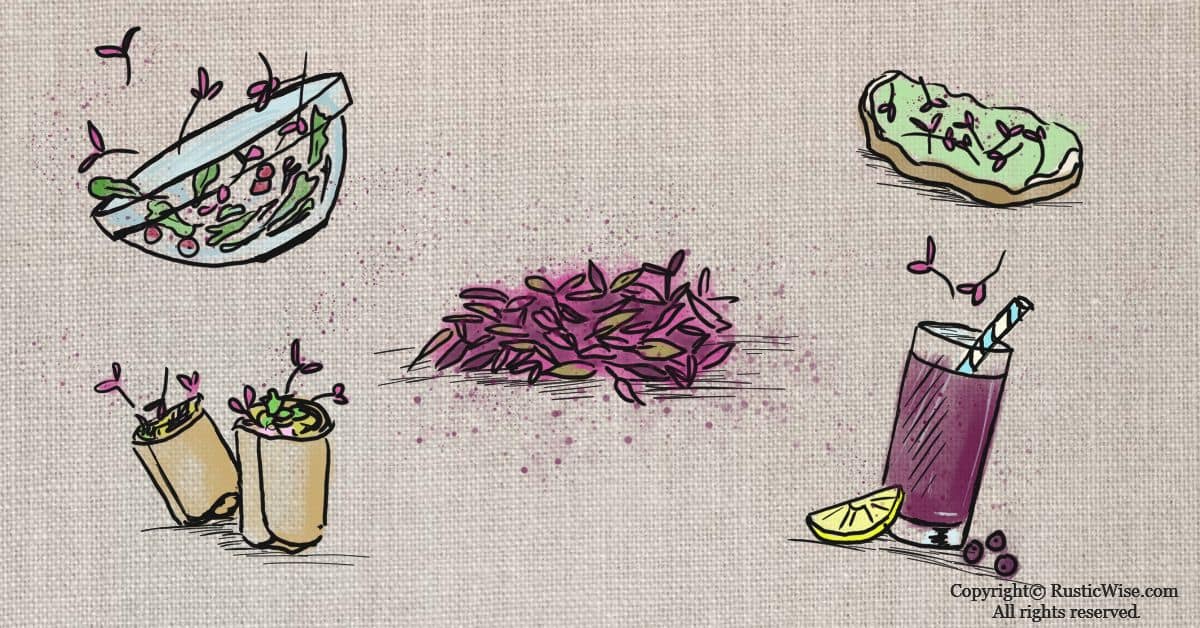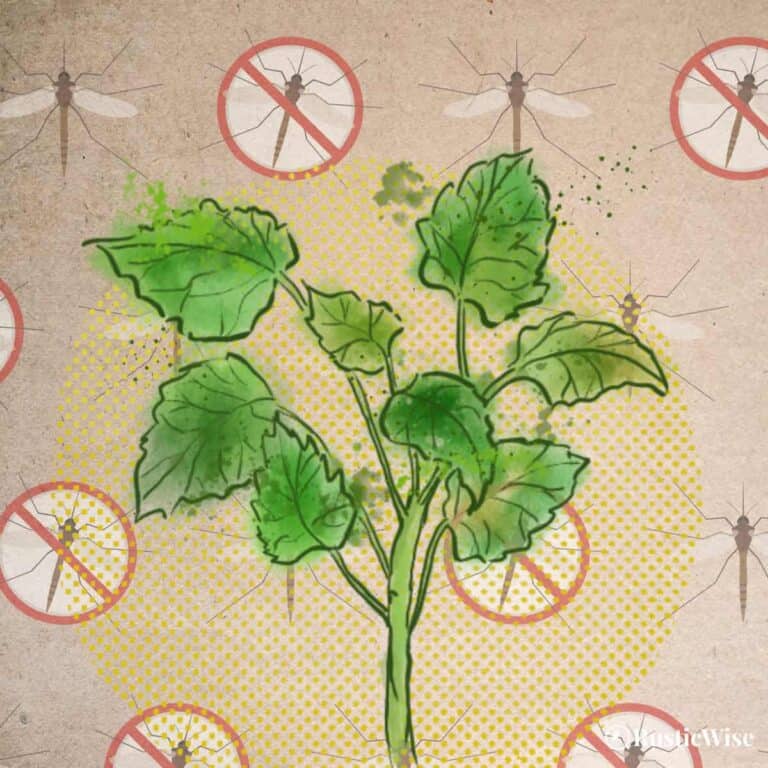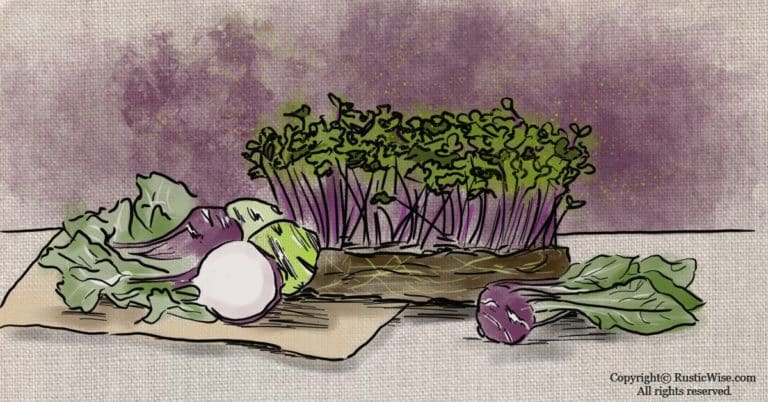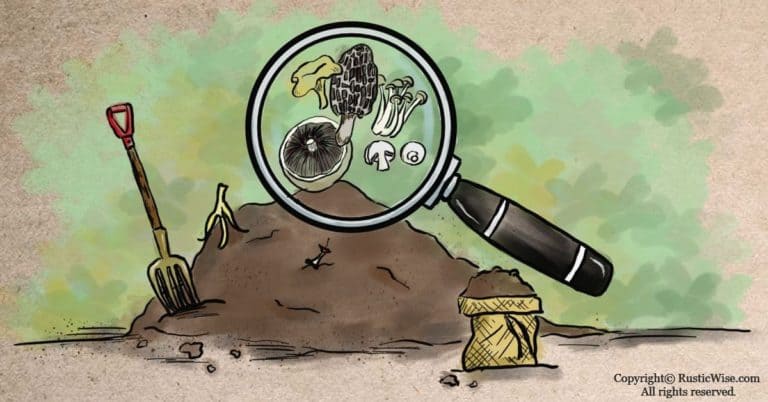Amaranth Microgreens Nutrition Facts, Recipes and How To Grow Them
Amaranth is an ancient plant that has many versatile uses. Its seeds are used as grain and its leaves are cultivated as a leafy vegetable. Nowadays, this plant is also grown as microgreens indoors. We’ll take a look at amaranth microgreens nutrition facts, how to use them, plus a few tasty amaranth microgreens recipes.
Did you know that amaranth microgreens are high in vitamin A, C and E? Amaranth is also a rich source of protein, iron, calcium and magnesium.
Let’s take a closer look at this ancient plant and how you can use it.
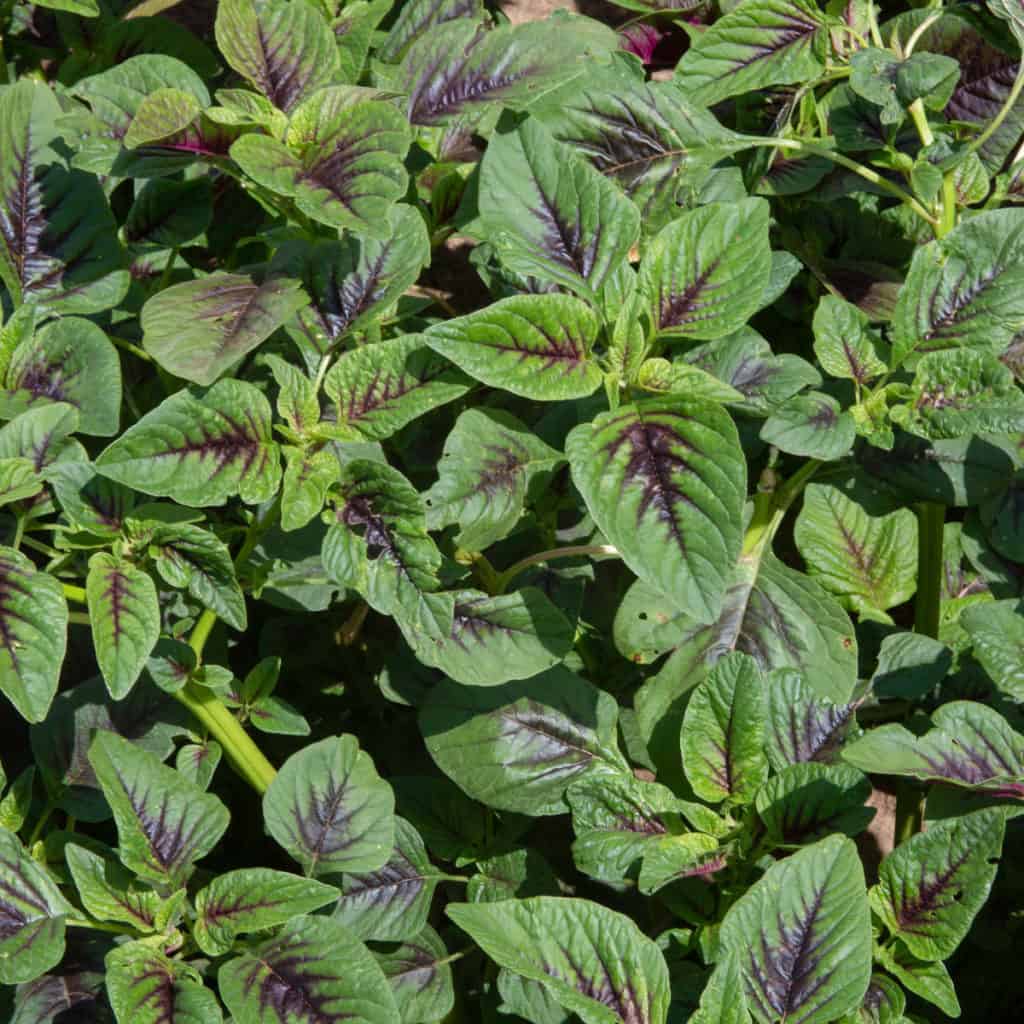
Credit: Jay Howard / Flickr
What is amaranth?
Amaranth belongs to the Amaranthaceae family under the genus Amaranthus. There are around 75 species around the world. It’s grown as both an annual or a short-lived perennial plant.
Amaranth is a flowering herb that comes from the same family as beets, spinach and quinoa. It’s found in parts of Africa, Asia, Europe, and North America for its leaves, seeds or flowers.
Some species of Amaranthus commonly called pigweed are considered invasive weeds in some areas as they pose problems to crops. However, amaranth is much more than a weed!
Generally, the amaranth species cultivated for their leaves are unique from those grown for their seeds (or pseudograins). Common species cultivated for the leafy greens are A. tricolor and A. dubius. Varieties grown for their grain include A. hypochondriacus, A. caudatus, and A. cruentus.
Amaranth grains were ground up and used along with maize by the Aztecs in the 16th century to make a variety of foods. In Mexican culture, amaranth grains are commonly popped and eaten as a snack or added to cereals.
Today, amaranth remains a popular breakfast for the health-conscious crowd as it’s gluten-free. It’s cooked as a porridge or a rice alternative. Amaranth contains more protein than rice and is also rich in fiber and iron.
Amaranth seeds are used to extract squalene, an emollient compound used in cosmetics.
The Hopi people, a Native American tribe, used amaranth flowers to produce a red dye.
Amaranth greens are a mainstay in Asian and African cultures. They are cooked as a stir fry and served with rice or noodles.
Garnet Red Amaranth is a popular variety used to grow tiny amaranth microgreens or sprouts. These are used as a garnish in salads, soups and sauces.
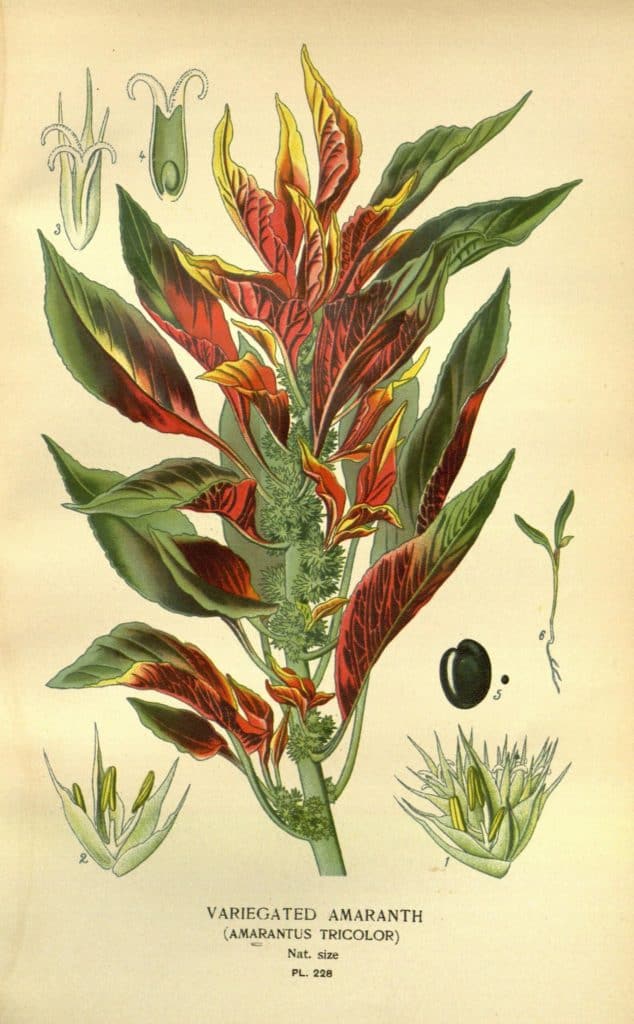
Credit: Biodiversity Heritage Library / Flickr
Amaranth microgreens nutrition facts
What are some health benefits of amaranth microgreens? Let’s take a closer look at amaranth microgreens nutrition facts.
According to data from the USDA, here’s the nutritional content of 100 grams of raw amaranth leaves: 23 calories (34 percent from protein, 10 percent from fat, and 55 percent from carbs).
| Raw Amaranth Leaves, Raw (100 grams) | |
|---|---|
| Calories | 23 |
| Protein | 2.5 grams |
| Carbs | 4 grams |
| Fiber | Data Unknown |
| Vitamin K | 950% the Daily Value |
| Vitamin C | 48% of the DV |
| Manganese | 38% of the DV |
| Folate | 21% of the DV |
| Calcium | 17% of the DV |
| Vitamin A | 16% of the DV |
| Iron | 13% of the DV |
| Magnesium | 13% of the DV |
| Potassium | 13% of the DV |
| Zinc | 8% of the DV |
| Phosphorous | 4% of the DV |
As you can see, amaranth contains a wide range of vitamins and minerals and is good source of amino acids.
Amaranth contains a huge amount of vitamin K in one serving—it contains 950% of the Daily Value based on a diet of 2,000 calories a day! Vitamin K plays a vital role in blood clotting which speeds up the time of wound recovery. Vitamin K also contributes to healthy bones. Adequate vitamin K content can be difficult to come by in most diets.
You’ll also find an abundance of vitamin C. Vitamin C helps protect and maintain the body’s cells; promote healthy skin, blood vessels, cartilage and bones; and helps to heal wounds.
Amaranth is a good source of manganese which helps to create and activate enzymes in the body. These enzymes do a variety of things including breaking down or digesting food.
Folate or folic acid, a vitamin that most people don’t get enough of, is found in amaranth. Folate is vital in creating new cells, an especially important vitamin for pregnant women.
For a leafy green, amaranth is packed with protein. Amaranth greens and microgreens are great for those on vegetarian or vegan diets.
Amaranth also has the following health benefits:
- High in calcium and magnesium
- Contains all nine vital amino acids
- Contains plenty of antioxidants like carotenoids and chlorophyll along with other phytonutrients such as lutein, zeaxanthin and beta-carotene.
In the microgreens world, amaranth, in particular garnet amaranth microgreens, are one of the healthiest around. A 2012 study conducted by the University of Maryland along with the U.S. Department of Agriculture (USDA) examined 25 varieties of microgreens for their nutritional content.
Specifically, they looked at:
- Vitamin C (ascorbic acid)
- Vitamin E (tocopherols)
- Vitamin K (phylloquinone)
- Vitamin A (beta-carotene)
Of the 25 different varieties of microgreens, garnet amaranth was one of the top four microgreens that contained the highest levels of vitamins C, E, A, and K. Others to score high include red cabbage, cilantro, and green daikon radish.
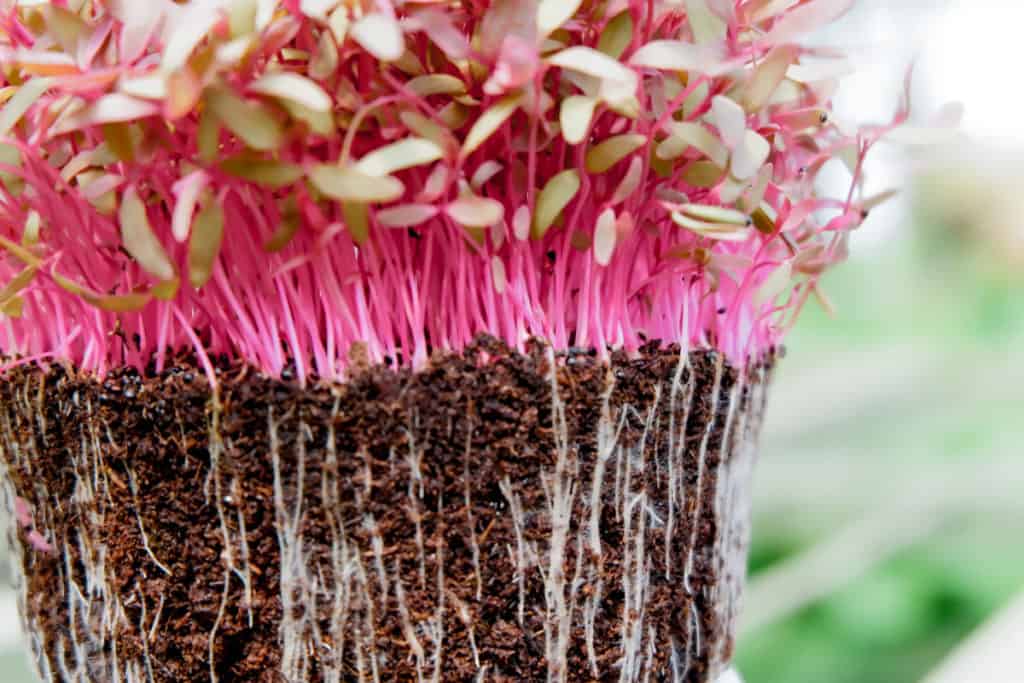
Credit: Devi Puspita Amartha Yahya / Unsplash
How to grow amaranth microgreens
Now that you know how nutritious this plant is, I bet you want to try growing it at home! While you could plant full-sized plants in your backyard, growing microgreens is great if you don’t have a lot of space, or time.
While there are different types of amaranth, these instructions are for garnet amaranth microgreens.
Let’s gather a few supplies!
You’ll need:
- Growing tray and cover: Your growing tray should have drainage holes to help you with bottom watering. Use the cover during the blackout phase.
- Growing medium: Organic potting mix or a growing medium like coconut coir.
- Amaranth microgreen seeds: You use about 1 ounce (28 grams) of seed per each 10 X 20 inch grow tray. There’s no need to pre-soak the seeds.
- Water mister
Ready to harvest: 8–12 days
Notes: This microgreen likes to stay warm. Keep it in a warm spot to help kickstart the germination process. Afterwards, provide light, but keep out of direct sunlight.
- Prepare growing medium. Fill the growing tray with 1–2 inches (2.5–5.1 centimeters) of potting mix or growing medium. Thoroughly moisten the growing medium. It should feel moist, but not too soggy.
- Broadcast seeds. Spread an even layer of microgreens seeds across the surface of the soil. Use your hands, or a small piece of cardboard to gently press the seeds into the soil. Give the seeds a gentle mist with water.
- Place cover on. Now it’s time to begin the blackout/germination phase! Place a cover over the seeds and place in a dark place at room temperature. Continue to mist as needed once a day remembering to replace the cover each time. Germination takes place in 2–3 days.
- Bring into the light. Once you see signs of growth you, can remove the cover (on days 3–4) and place near a sunny window (but away from direct sunlight), or under grow lights.
- Water. Keep your microgreens happy and healthy by bottom watering them once or twice a day. Simply fill a larger tray, basin, or a clean sink with about 1/2-inch (1.3 centimeter) of water. Place your tray of microgreens into the water for several minutes. This helps to ensure they are evenly watered and protects the fragile shoots at the same time.
- Harvest. Your garnet amaranth microgreens will look lovely at this point with their vibrant leaves and stems ranging from fuchsia to deep burgundy. Harvest according to taste, typically between 8–12 days. Use a pair of sharp scissors or a knife and snip just above the surface of the soil.
Enjoy your microgreens fresh and harvest right before eating. Give them a quick rinse beforehand!
How to use amaranth microgreens
Amaranth microgreens are tender and best used raw. They don’t stand up well to heat.
Different varieties of amaranth microgreens produce different flavors. Some varieties like garnet amaranth lean more towards earthy and full-flavored (like a milder version of mustard). Other green varieties may taste slightly nutty. Amaranth pairs well with both sweet and savory dishes.
Red amaranth pairs well with green apples, carrots, oranges, onions, peppers, and light cooked meals such as seafood.
Here are a few ways to use red amaranth microgreens:
- Add as a garnish to cooked dishes like omelettes, fish, and soup.
- Add to fresh salads.
- Add some zest to sandwiches, wrap, and tacos.
- Add to smoothies for a vitamin-punch.
- Garnish cocktails (think martinis or Bloody Mary’s) both sweet and savory.
Amaranth microgreens recipes
Here’s a few recipe ideas on how to use amaranth microgreens.
Honey Amaranth Smoothie
Sweet amaranth microgreens pair perfectly with raspberries, peaches, and blueberries for a tasty smoothie (via Sprout Organic Farms).
Citrus Seared Scallops
Brighten up this seared scallops dish with a splash of microgreens (via Spoon Fork Bacon).
Roasted Pear Soup
Top off this roasted pear soap with ginger with some fresh, dazzling microgreens (Ciao Florentina).
Microgreens Salad with Quinoa, Pancetta and Pomegranate
We think garnet amaranth microgreens would be the perfect thing to complete this flavorful and healthy salad (via Garlic Girl).
Related Questions
Is amaranth banned in the US?
Amaranth red dye has been banned in the US since 1976 by the U.S. Food and and Drug Administration as a possible carcinogen. The amaranth dye was used as a food additive. Interestingly, “Red Dye No. 2” is actually made of synthetic ingredients and not directly derived from the plant.
How do you cook amaranth grains?
Cooked amaranth grains are a popular, healthy choice for breakfast. Think of it as a gluten-free version of porridge or oatmeal. You can cook amaranth in a pot on the stove, or in a rice cooker for a hands-off approach. It usually takes 25–35 minutes to cook, but you can do this ahead of time and keep for several days in the fridge. Check out this post for ideas on how to use amaranth grains for breakfast.
👉 If you like this post, see our Complete Guide to Growing Microgreens at Home. 🌱
Would you like more timeless tips via email?
Fun tips to help you live an independent, self-sustaining lifestyle. Opt-out at any time.


References:
- University of Missouri, Amaranthus: Not Just a Weed, https://ipm.missouri.edu/MEG/2020/2/amaranthus/. Accessed April 2021.
- USDA My Food Data, Amaranth Leaves Raw, https://tools.myfooddata.com/nutrition-facts/168385/100g/1. Accessed April 2021.
- National Health Service (NHS) UK, Vitamin K, https://www.nhs.uk/conditions/vitamins-and-minerals/vitamin-k/. Accessed April 2021.
- Lester, Gene & Xiao, Zhenlei & Luo, Yaguang & Wang, Qin. (2013). Microgreens: Assessment of Nutrient Concentrations. Journal of Agricultural and Food Chemistry. Accessed April 2021. https://www.researchgate.net/publication/267354000_Microgreens_Assessment_of_Nutrient_Concentrations
- True Leaf Market, AMARANTH – RED GARNET – MICROGREENS SEEDS, https://www.trueleafmarket.com/products/amaranth-sprouting-red-garnet-seeds-conventional?variant=31844352950387. Accessed April 2021.

Author: Josh Tesolin
Josh is co-founder of RusticWise. When he’s not tinkering in the garden, or fixing something around the house, you can find him working on a vast array of random side projects.

